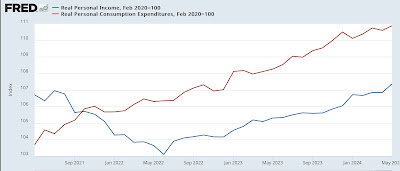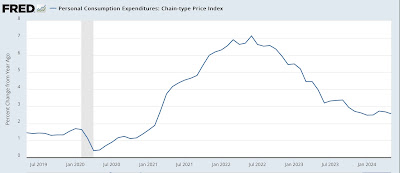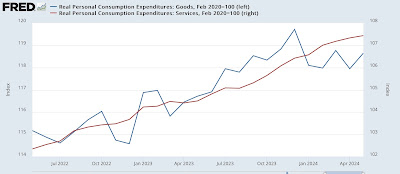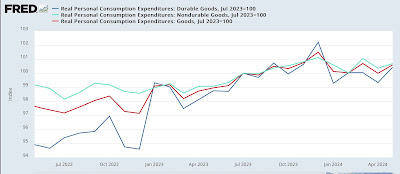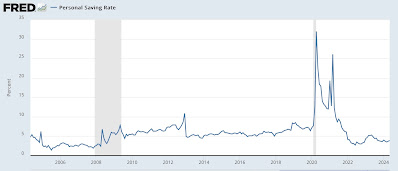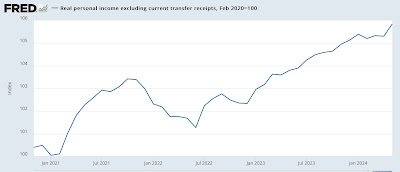– by New Deal democrat Personal income and spending, in addition to the jobs report, has become one of the most important monthly reports I follow, mainly because I am looking for signs that the contractionary effects of Fed tightening are finally taking effect. To cut to the chase, this month’s report was mainly positive, but had a few cautionary signs. To reiterate from last month: because real personal spending on services for the past 50 years has generally risen even during recessions, the more leading components of this report have to do with spending on goods. Additionally, there are several components that form part of the NBER’s “official” toolkit for determining when and whether a recession has begun, including real spending minus
Topics:
NewDealdemocrat considers the following as important: May 2024, US EConomics
This could be interesting, too:
NewDealdemocrat writes JOLTS revisions from Yesterday’s Report
Bill Haskell writes The North American Automobile Industry Waits for Trump and the Gov. to Act
Bill Haskell writes Families Struggle Paying for Child Care While Working
Joel Eissenberg writes Time for Senate Dems to stand up against Trump/Musk
– by New Deal democrat
Personal income and spending, in addition to the jobs report, has become one of the most important monthly reports I follow, mainly because I am looking for signs that the contractionary effects of Fed tightening are finally taking effect. To cut to the chase, this month’s report was mainly positive, but had a few cautionary signs.
To reiterate from last month: because real personal spending on services for the past 50 years has generally risen even during recessions, the more leading components of this report have to do with spending on goods. Additionally, there are several components that form part of the NBER’s “official” toolkit for determining when and whether a recession has begun, including real spending minus government transfers, and real total business sales.
Let’s look at each of them in turn. Note that most of the graphs below except for YoY comparisons are normed to 100 as of just before the pandemic.
Real income and spending
In May, nominally income rose 0.5%, while nominal spending rose 0.2%. Since prices as measured by the PCE deflator rounded to unchanged for the month, in real terms income was unchanged and spending rounded to 0.3%. Since the pandemic recession, real spending is up 10.9% and real income is up 7.4%:
On a YoY basis, the PCE price index is up 2.6%, the fourth month in a row higher than January’s three year revised low of 2.5%. While in the previous 16 months, the YoY measure had been declining at the rate of 0.25%/month, suggesting that it would hit the Fed’s 2.0% target this spring, that trend may have ended. On the other hand, there is no indication at this point that the inflation rate is actually increasing either:
As I have been noting for the past few months, for the past 50+ years, real spending on services has generally increased even during recessions. It is real spending on goods which declines. Last month real services spending (right scale) rose 0.1%, while real goods spending (left scale) rose 0.6%:
Breaking goods spending down further, in May spending on consumer durables (dark blue) rose 1.1%, while real spending on non-durables rose 0.3%(light blue). In the past, spending on durables has tended to turn down before spending on non-durables. Here’s the current update, also including real spending on goods as a whole, as per the previous graph. Note that I normed this graph to 100 as of last July:
While on a YoY basis, all three series are running about 1.7% higher, which is within the range of normalcy since the turn of the Millennium, note that since last July real spending on goods is only higher by 0.6%, on durables by 0.4%, and on non-durables by 0.7%. While spending on durable goods is particularly volatile, so the near-stall in that spending is not particularly foreboding, it is increasingly a yellow flag caution for the economy going forward.
Savings
Another important metric for the near future of the economy is the personal savings rate. In May it rose to 3.9%. This remains in the range it has been in since last September. This longer term look shows how the present compares with the all time low rate of 1.4% in 2005:
While historically this is a very low rate, with only 2005-07 and 2022 significantly lower, indicating consumers are vulnerable to a financial shock, there is no such shock indicated at the moment.
Important coincident measures for the NBER
Also as indicated above, the NBER pays particular attention to several other aspects of this release. Real income excluding government transfers (like the 2020 and 2021 stimulus payments) rose 0.5% in May to yet another new record high. Needless to say, this is good, especially since it had stalled for three months previously:
Finally, the deflator in this morning’s report is used to calculate, with a one month delay, real manufacturing and trade sales. This declined another -0.1% in April, and for the fourth month in a row is below its November and December 2023 readings:
It remains higher by 2% YoY. As the historical graph below shows, before 1990 a deceleration like this typically was associated with recessions or within a year before. Since then, there have been many such pauses without it being significant in the longer term:
Summary
After April’s basically flat report, this was generally a good rebound. But the comparisons with last year are going to become much more challenging for goods spending, as well as for real manufacturing and trade sales beginning in a couple of months.
To reiterate my concluding comments from last month: “especially with the downturn in the past several months of the leading sector of housing under construction, what it does do is give a higher level of importance to next week’s ISM manufacturing and services reports. I will be looking to see if the weighted average of the two is trending higher, lower, or flat. Since the ISM manufacturing report in particular has a long history of leading the economy, should that weighted average decrease below its equipoise point of 50, that would mean that both leading sectors of the goods producing economy are forecasting further weakness ahead.”
Last month the weighted average of the ISM reports remained positive, while housing under construction declined further.
So: positive for now, watching the yellow caution flags.

